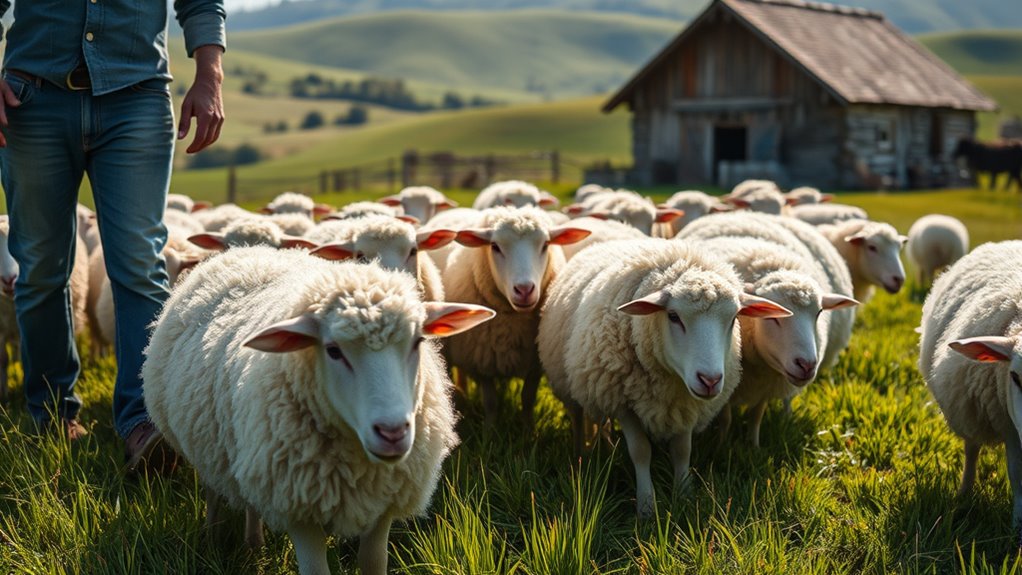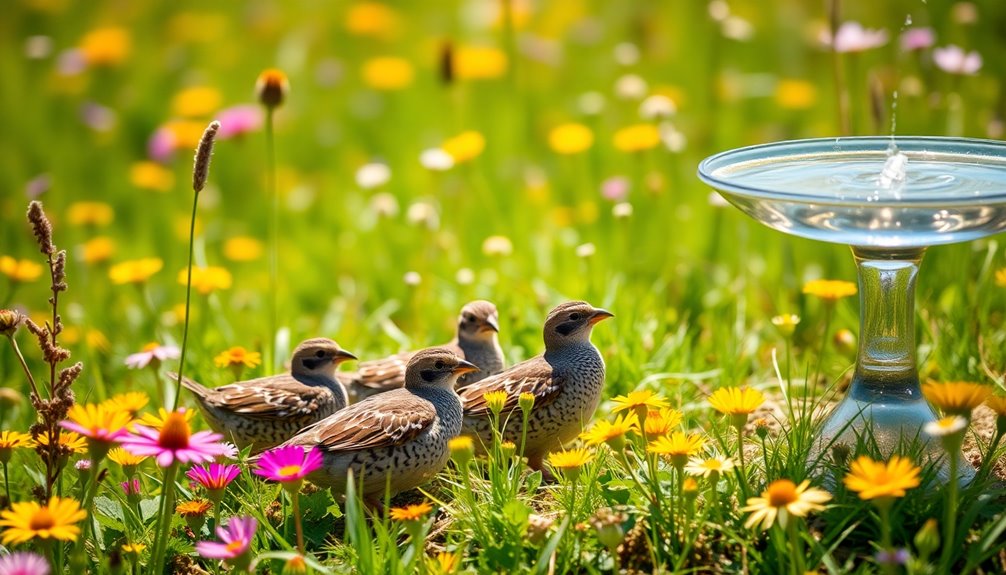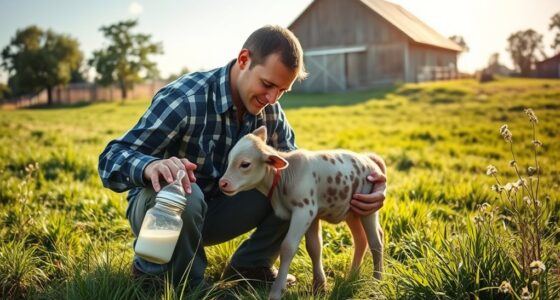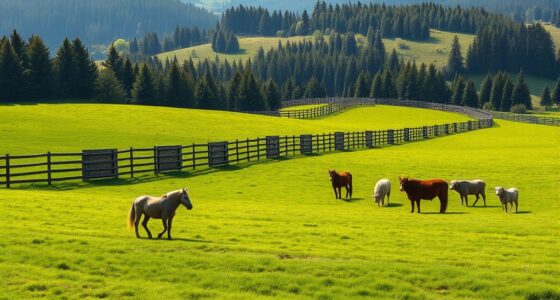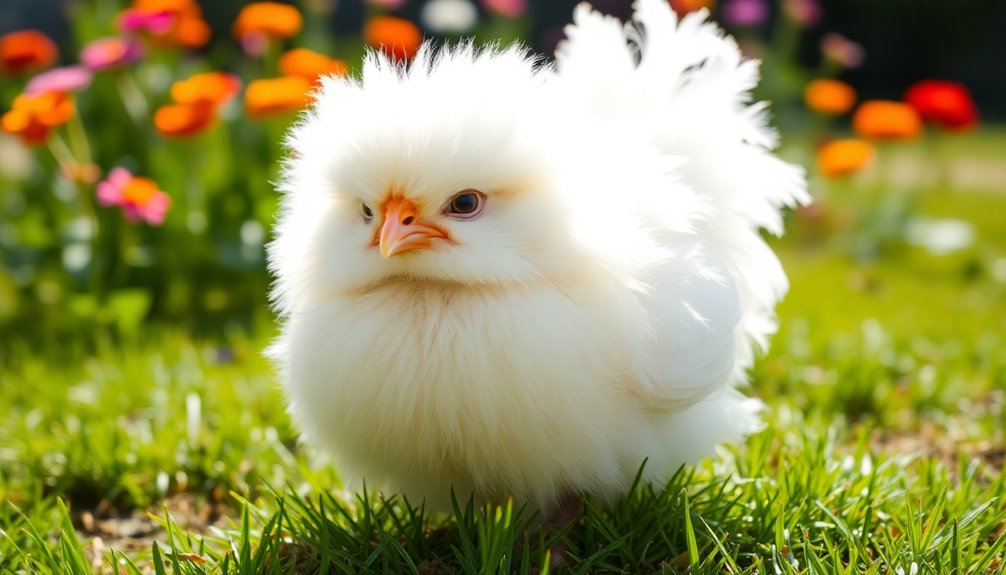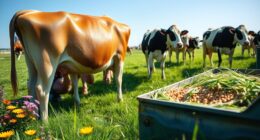To raise sheep for wool and meat on a small farm, you need to provide a balanced diet with high-quality forage and supplement with grains when needed, ensuring fresh water is always available. Protect your flock from predators by secure fencing, predator-proof gates, and occasional deterrents, while also considering guardian animals. Regularly check and maintain fencing and shelters, monitor sheep health, and adjust your management strategies accordingly. Continue exploring ways to optimize your flock’s health and safety for best results.
Key Takeaways
- Provide a balanced diet with high-quality forage and supplemental grains to ensure healthy wool and meat production.
- Install secure fencing and predator-proof enclosures to protect sheep from predators and ensure safety.
- Regularly monitor body condition and adjust nutrition to promote optimal growth, wool quality, and overall health.
- Implement predator deterrents like guardian animals, proper fencing, and vigilant predator checks.
- Maintain ongoing management through routine inspection, repairs, and tracking flock health and productivity.
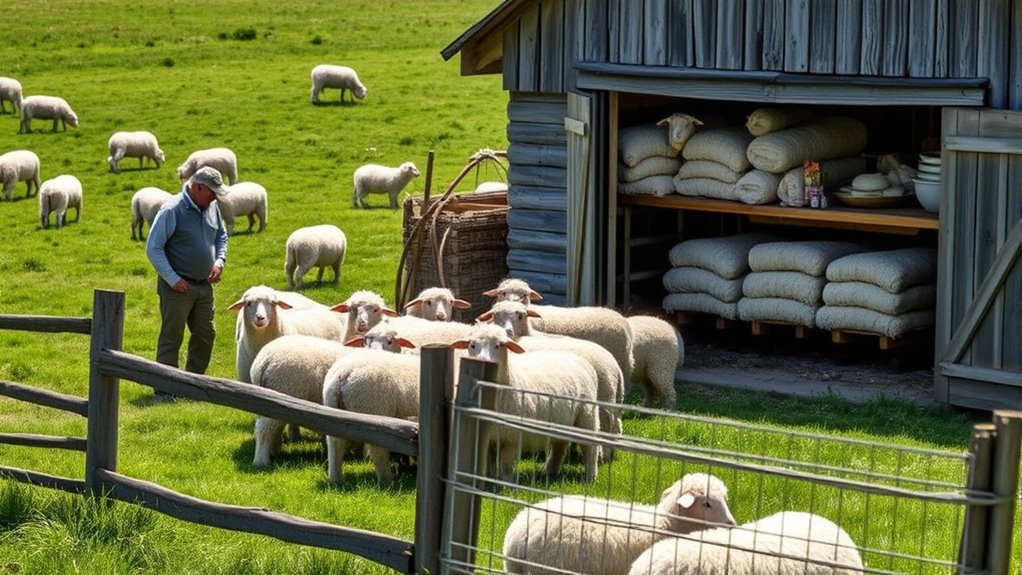
Raising sheep for both wool and meat can be a rewarding venture, but it requires careful planning and management. One of your top priorities should be ensuring proper sheep nutrition. Sheep need a balanced diet to stay healthy, grow efficiently, and produce quality wool and meat. This means providing them with high-quality forage, such as pasture grasses, along with supplemental grains if necessary, especially during winter or when pasture quality declines. Fresh water must always be accessible because dehydration can compromise their health and productivity. Regularly monitoring their body condition helps you adjust feeding strategies, making sure they aren’t under or overfed. Adequate nutrition also supports a strong immune system, reducing the risk of disease and minimizing veterinary costs. Incorporating goal setting and tracking progress through journaling can help you optimize your flock’s health and productivity. Alongside good nutrition, predator protection is essential for maintaining a safe flock. Predators like coyotes, dogs, or stray animals can threaten your sheep, especially if they graze in open fields. Installing secure fencing is your first line of defense. Use sturdy, high-tensile wire or woven fencing that sheep can’t push through or jump over. Consider burying fencing a few inches underground to prevent predators from digging underneath. In some cases, installing predator-proof gates or shelters where sheep can retreat provides extra security. Nighttime enclosures should be well-constructed, with locks and durable materials, to keep predators out while giving your sheep a safe space to rest. You also need to stay vigilant by regularly inspecting fencing and enclosures for weaknesses or damage. Motion-activated lights or alarms can act as deterrents, waking you if predators approach. If you notice signs of predator activity, such as tracks or damaged fencing, address the problem immediately to prevent future attacks. Livestock guardian animals, like dogs or llamas, can also be effective in deterring predators, but they need proper training and socialization. Managing sheep nutrition and predator protection go hand-in-hand in maintaining a healthy, productive flock. Providing adequate nutrition ensures your sheep stay strong and resilient, while effective predator protection minimizes the risk of loss. Both aspects require ongoing attention and maintenance, but the effort pays off with healthier sheep, higher quality wool, and better meat yields. Implementing proper fencing techniques and regular predator checks can dramatically reduce the likelihood of attacks. By staying proactive and attentive to these needs, you’ll create a safe, sustainable environment that supports your small farm’s success.
Frequently Asked Questions
What Are the Best Sheep Breeds for Small-Scale Farms?
When choosing the best sheep breed for your small farm, focus on sheep breed selection that fits your goals. Consider breeds like Dorset or Suffolk for meat, and Merino or Romney for wool. Look into wool quality assessment to guarantee the fleece meets your needs. By comparing breeds’ growth rates, climate adaptability, and wool or meat quality, you’ll find the perfect fit for your farm’s size and resources.
How Do I Prevent Common Sheep Diseases?
To prevent common sheep diseases, you should focus on parasite control and follow a proper vaccination schedule. Regularly check your sheep for signs of parasites like worms, and use safe dewormers as needed. Keep vaccinations up-to-date for diseases such as tetanus and clostridial infections. Maintaining clean living conditions and proper nutrition also help strengthen your sheep’s immune system, reducing their risk of illness.
What Are the Ideal Shelter Requirements for Sheep?
Did you know proper sheep housing can reduce health issues by 50%? For ideal shelter design, you need well-ventilated, dry, and draft-free shelter to keep your sheep comfortable and healthy. Guarantee ample space for movement, with good drainage and protection from extreme weather. Adequate shelter design also includes clean bedding and easy access to food and water, making your sheep’s environment safe and cozy year-round.
How Do I Determine the Right Age for Slaughter?
You should consider sheep age guidelines to determine the best slaughter timing. Generally, lambs are ideal for meat when they’re around 6 to 8 months old, offering tender meat and good growth. For meat quality, avoid slaughtering too young or too old. Monitoring growth rates and breed characteristics helps you decide the right age, ensuring meat tenderness and flavor while maximizing efficiency and profitability.
What Are Sustainable Grazing Practices for Sheep?
Sustainable grazing isn’t just about letting sheep roam free; it’s about thoughtful pasture management and rotational grazing. You move sheep regularly to prevent overgrazing, allowing pasture plants time to recover. This balance protects soil health and encourages biodiversity. By practicing rotational grazing, you guarantee your sheep have nutritious pasture, reduce environmental impact, and create a resilient farm system that benefits both your flock and the land.
Conclusion
Raising sheep on your small farm is like tending a living tapestry, where each woolly thread and tender cut of meat weaves into a vibrant story. With patience and care, you become the artist shaping a harmonious harmony between nature and nurture. Your efforts bloom into a symphony of sustainable harvests, turning simple sheep into treasures that nurture both body and soul. In this gentle dance, you find the true rhythm of farm life’s enduring beauty.

